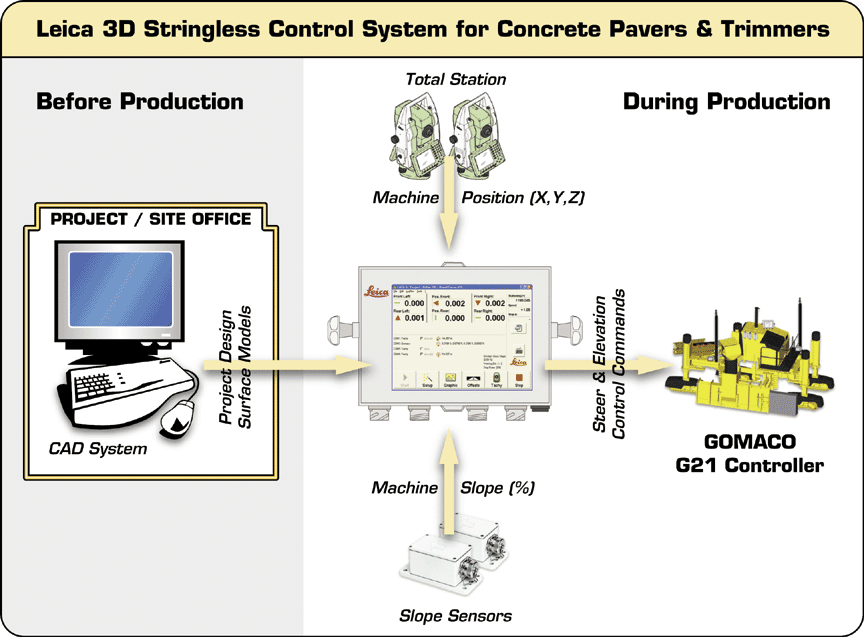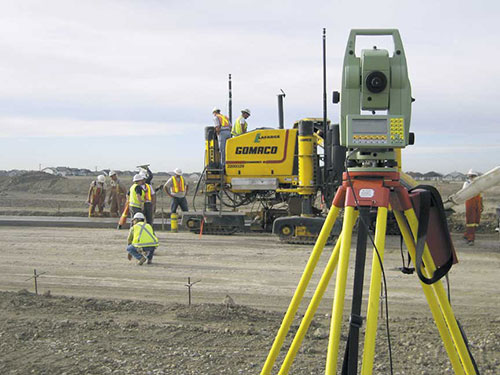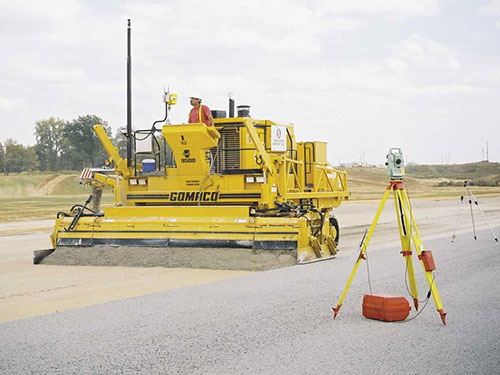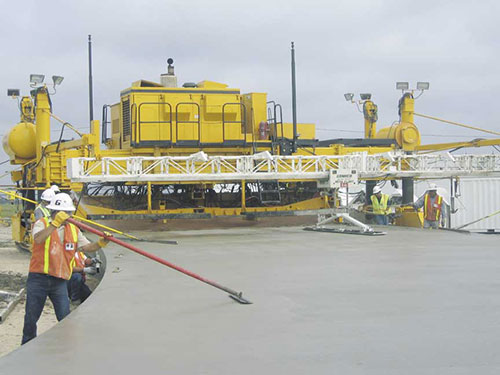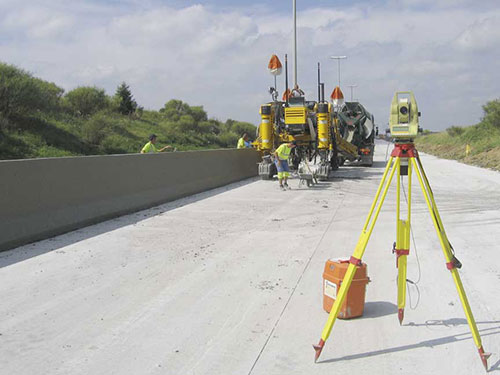GOMACO World Index --- GOMACO World 34.1 - February 2006
Stringless Is Here!
Editor’s Note: The first GOMACO World technical article on 3D stringless paving appeared in the magazine in December 1999, in Volume 27, Number 4. It announced the cooperation between GOMACO and Leica Geosystems, in Heerbrugg, Switzerland, to develop a stringless guidance system. The key advantage to making 3D stringless paving work on GOMACO machines was the CAN (controller area network)-based G21 controller.
“We feel we have an advantage over any of the other industry players because of our CAN-based G21 controller,” Kevin Klein, GOMACO Research and Development Manager, said in 1997. “It’s one of the key reasons the Leica system works with GOMACO equipment.”
Today, it’s still the magic of the G21’s CAN-Bus network that allows GOMACO equipment to work so seamlessly with the stringless technology. A recent interview with Karl Soar, Product Manager for Paving Systems for Leica Geosystems, reveals some insight into the plug and play technology of the system, advances in the stringless system, and other issues. Here’s what he had to say...
Why does your system work so well with the GOMACO G21 controller?
The G21 controller works on a technology called CAN-Bus. The way I like to describe CAN-Bus to customers is that it’s like “internet for machines.” It’s a communications method that allows all the different sensors on the machine, plus engine components and circuits, to communicate with each other over one common cable network. Much like PCs in an office can share printers and exchange information with each other, CAN-Bus allows a machine to do that. The information that can be exchanged on CAN-Bus is anything from engine and oil temperature and pressure to 3D position data and hydraulic control signals.
Our 3D control system for stringless paving is built around CAN-Bus technology and we’ve been working on this together with GOMACO since 1999. We defined a message system which allows our machine computer and software to share the CAN-Bus network on GOMACO machines and send out our steering and grade commands to the G21 controller, which then talks to the valves in a similar way as it would to a stringline sensor.
What are the advantages of a CAN-Bus working with your system?
The advantage of a CAN-Bus is that it is extremely fault tolerant. For example, if there is any electrical interference on or around the machine, CAN-Bus itself is not affected by that. It’s a voltage differential system and if there are any changes in the background voltage of the machine, such as when operators crank the starter or adjust engine revs, the CAN-Bus messages are not affected by that.
It’s also extremely fast. The CAN-Bus messaging system that we use together with GOMACO runs at 125 kilobits– very fast compared to older serial communication methods which also aren’t as flexible or reconfigurable as CAN-Bus. The key advantages are robustness and speed.
Is it safe? What keeps contractors from trimming or paving out of tolerances?
The CAN-Bus allows us to take advantage of safety features that are built into the G21 controller. For example, if an error is detected with our system because the machine is not in the position it needs to be, we send out a stop command and the machine will stop. We only need to send one small message across to the G21 and it takes care of shutting down the travel circuits, the vibrators, augers and tampers and locks the hydraulics on the legs.
That’s a huge advantage for us, because we only have to define one message standard that allows us to set the GOMACO machine into standby. Once it’s in standby, the G21 controller will not let the machine move again until the error condition has been cleared or the Leica system detects that the fault has been fixed. It’s a very safe technology in that respect. Correctly set up, it simply won’t let the customer put concrete in the wrong place on line or level. We can set limits in our system that as soon as we see the machine is more than a pre-defined amount away from where it should be, a stop command is instantly sent to the machine.
For example, imagine the operator has forgotten to put the grade control loops into automatic and he tries to start paving. Our system will immediately detect that the machine is not within a couple of millimeters of where it should be and it will send a stop command instantly onto the CAN-Bus. That stop command is picked up by the G21 controller which does all the rest of the work. We just need to say, here’s the message, do something with it and the G21 takes care of the rest.
What’s the latest development with the system?
Another advantage of the G21 controller is the large program space it has available. It’s allowed GOMACO and Leica to develop a new feature which we call mixed-mode paving configuration. It’s particularly useful on airport projects where contractors have to pave pilot lanes.
Let’s imagine that the contractor has to pave five lanes total, all adjacent to each other. Typically on an airport you would pave lane #1, then #3, then #5, and come back and do the fill-in lanes #2 and #4. Where they have to connect to an existing slab, obviously, they need a smooth joint with no step elevation changes between the two slabs. In that situation, our mixed-mode paving allows us, with the 3D system, to steer the machine so the contractor doesn’t have to put up any temporary stringlines. They can then lock-to-grade with the track legs to perfectly match the grade of the adjacent slabs.
It also allows scab-on paving. When a contractor is scabbing-on to the side of an existing slab, they can run lock-to-grade on that side of the paver and 3D control on the opposite side so they’re able to smoothly connect to the existing concrete. It’s a neat little feature.
What troubleshooting capabilities does the operator have?
The G21 has diagnostics screens that allow the operator to troubleshoot very quickly if there are any communication problems with the CAN Bus. If for some unfortunate reason the Leica computer gets damaged or the power supply to our computer fails, the G21 will instantly detect that the Leica computer is no longer on the network and put the machine into standby. This prevents any risk of concrete going in the wrong place or the wrong grade. There are a lot of safety features, time-outs and cut-outs in the system that prevent any risk of incorrect paving. That’s extremely important. Safety is the key. We’ve put a lot of engineering into our system to make sure it is as bullet-proof as possible.
What is the biggest objection you hear from contractors when you talk to them about stringless paving?
Surprising as it might sound, we’ve been meeting customers and selling this technology in Europe since 1999. Believe me, we’ve heard every objection in the book! To be honest, since we launched stringless with GOMACO in the United States, we’re hearing more positive comments than objections! One of the biggest objections we still hear is, “I can’t see my strings. I can’t see if there are design errors in there. How can I trust the stringless system will keep the machine in the right place?” Of course, with stringless technology, the most common errors – i.e, the human errors in hub-setting, pin-driving, clamp setting, line-levelling and tensioning, plus the dreaded “catenary-effect” of slack stringlines that often leads to poor ride quality are completely eliminated. The machine is running from a “perfect” computer model of the finished project. Mistakes can happen. The data model itself just might have some errors in it, and contractors need to have the confidence that they can still check the model. That’s where we can help.
We actually handle a lot of that ourselves in the 3D system. We have the graphic capability to actually look at the design, which we like to call “virtual stringlines” and see that the elevations and slopes are correct on each piece of the model. Just clicking on a piece of the model tells you all the information you need to know about it.
Even prior to putting the model on the machine to pave, you can load that model into any CAD system in a 3D view mode and you can literally “fly-through” your project. It takes just a couple of mouse clicks to exaggerate the vertical scale of an electronic drawing, or even generate a full contour map so you can look for any high or low spots in your “virtual stringlines.” It’s the same process of somebody getting down on their hands and knees and looking down a physical stringline for any low spots.
The beauty of the “software version” of virtual stringlines is that you can be sitting in a nice, warm office with a cup of coffee just clicking through a CAD program and you can spot any design errors before you even take that model out to the machine. You can overlay existing features and compare the model to your subgrade.
Imagine a contractor paving an airport runway... the subgrade has been put in and it’s an inch or so high. They have to go in and trim that to spec with their trimmer. One thing the contractor can do first is a grid-level survey where they take spot heights and form a rectangular pattern to build up a surface model of their existing subgrade. From that, they can work out the amount of material and know how it relates to the theoretical design level for the subgrade.
They can instantly work out how much volume of material they’re going to take off with their trimmer. The contractor can use that very same model that they’ve used for trimming, dial in the thickness of the slab they want to pave, put it into the computer on the paver and go pave it. They don’t need to generate another model, assuming that their concrete is a constant thickness slab design. They might have an 18 inch (457 mm) slab, so just dial in 18 inch (457 mm) offset, upwards from subgrade level, and there’s your finished concrete level to go pave with.
The preferred alternative is even better, but does require owners, designers and contractors to cooperate. It’s now 2006, and pretty much everything is designed in CAD, so why not use it as it is? Where’s the benefit in taking a good electronic design, plotting it onto paper, reading or scaling-off the design, manually surveying and staking it out and introduce all those possibilities for errors?
Just get the top-of-concrete levels and slab positions from the designers directly in an electronic file. Double-check it first, of course, but then put it straight into the Leica system. Dial in that 18 inch (457 mm) offset as a negative number (i.e. a “cut”) and go trim the subgrade perfect relative to top-of-concrete. Move the Leica system onto the paver, reset the offset to zero, and off you go! Imagine how much time, money, effort and material that can save you over a sizeable project!
Where has my stringline gone?
Another big objection is... “Where has my stringline gone? I’ve got nothing to check against.” As time progresses, contractors are going to realize that’s not something they need to worry about anymore.
The fear that the machine is going to go in the wrong place is taken care of by our system in connection with the G21. The secret to all that apparently complex communication is the CAN-Bus. We use our robotic total stations for position, and slope sensors for orientation of the machine, to figure out how much height, steer and crossfall adjustment it needs, plus how much draft, and mainfall to provide.
We just hook the slope sensors up to the GOMACO machine installing them on the GOMACO mounting brackets, connect one cable allowing the G21, our Leica system and our slope sensors to all talk on the same network. It’s a fast and super-reliable technology.
The fear the customer has that the Leica system doesn’t somehow integrate with their processes and doesn’t integrate well with the machine, that it’s some kind of bolt-on effort, is really not the case at all.
Is this system plug and play technology between the Leica stringless system and GOMACO’s G21 controller?
It’s pure plug and play technology. In fact, we call it “Plug & Pave!” That’s exactly what it is, because as soon as we fire up our computer and are on the CAN-Bus, we recognize the G21, the G21 recognizes us, and you’re ready to go pave.
If the contractor needs to go to one of the mixed-mode paving options, paving left or right grade, it’s just a case of them selecting the appropriate mode on the G21, restarting the G21, running that new mode and away they go. It’s really just press a button and flip a switch.
What about the average machine operator? Are they going to be able to operate this system?
It’s complete rubbish for anyone to say the average operator won’t be able to handle this system, that it’s too complicated for them. Why would GOMACO be the market leader if their products were too complicated for people to use? And why would Leica be the world’s leading surveying equipment manufacturer if no one could switch on our total stations? You just have to have a team of guys that are willing to go through the learning curve, because there is a learning curve involved.
As far as training the machine operator... it takes us no more than 10 to 15 minutes to get the operator up to speed on what needs to be done. It’s really just a case of you used to pave in dual-grade left or dual-grade right, now press that button one more time and the Leica mode comes up.
On our Leica system, there’s only three or four buttons the operator really needs to know. Those are start, stop and offsets so he can change the position and attitude of the machine on the fly if he needs to adjust for concrete variances.
Once our system is up, measuring, and sending steer and grade commands to the G21, the operator just has to remember to put the G21 into the Leica mode before he goes to pave and everything is the same as it would be on string. All he has to do is occasionally glance an eye over the Leica computer to see that everything looks sensible.
Remember, if there’s an issue, a red warning light flashes on our system and the machine stops. The operator has to take a quick look at the diagnostics on the G21 and it displays something like “Leica stopped tracking, reset Leica.” It won’t let him start paving again until the diagnosis is dealt with.
It is a new way to pave, but our customers get comfortable with it very quickly. Once they’ve gone through that learning curve, the world is their oyster and they never want to go back to stringline. It’s so frustrating when some people see this technology and just attack it and say it doesn’t work. All we ask is for people to just give it a fair hearing, then call us or GOMACO and arrange to try it for themselves. We know they’ll be impressed!
Subscribe to Receive GOMACO World Magazine
